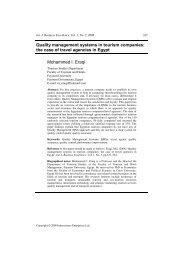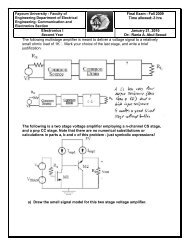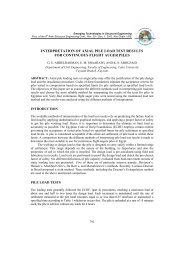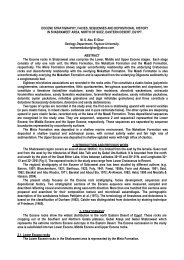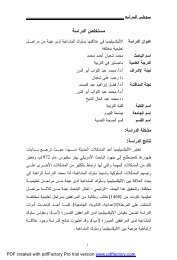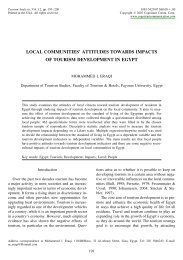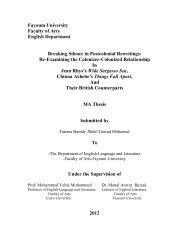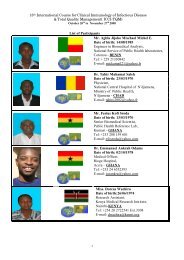Answer the following Questions:- Question 1:- Answer True or False ...
Answer the following Questions:- Question 1:- Answer True or False ...
Answer the following Questions:- Question 1:- Answer True or False ...
Create successful ePaper yourself
Turn your PDF publications into a flip-book with our unique Google optimized e-Paper software.
Fayoum University - Faculty of<br />
Engineering Dept. of Electrical<br />
Engineering- Communication and<br />
Electronics Section<br />
Computer Netw<strong>or</strong>ks I<br />
F<strong>or</strong>th Year<br />
Final Exam - Fall 2009<br />
Time allowed:- 3 hrs<br />
January 24 th 2010<br />
Dr:- Rania A. Abul Seoud<br />
<strong>Answer</strong> <strong>the</strong> <strong>following</strong> <strong><strong>Question</strong>s</strong>:-<br />
<strong>Question</strong> 1:- <strong>Answer</strong> <strong>True</strong> <strong>or</strong> <strong>False</strong> f<strong>or</strong> <strong>the</strong> <strong>following</strong> statements.<br />
١. [ T ]The longer <strong>the</strong> frames <strong>or</strong> <strong>the</strong> sh<strong>or</strong>ter <strong>the</strong> propagation time, <strong>the</strong> higher<br />
utilization (efficiency) can be achieved in E<strong>the</strong>rnet LANs.<br />
٢. [ T ]With Go-back-N err<strong>or</strong> control protocol, it is not required that each<br />
individual frame be acknowledged.<br />
٣. [ F ]In CSMA/CD LANs, <strong>the</strong> amount of time that it takes to detect a collision<br />
is never greater than <strong>the</strong> end-to-end propagation delay.<br />
٤. [ T ]When <strong>the</strong> bit length of <strong>the</strong> link is greater than <strong>the</strong> frame length, multiple<br />
frames can be in transit at one time.<br />
٥. When a switch sends a frame towards <strong>the</strong> final destination over a full<br />
duplex E<strong>the</strong>rnet interface, it should put as destination MAC address <strong>the</strong><br />
MAC address of <strong>the</strong> next hop. Solution: <strong>False</strong>; <strong>the</strong> bridge does not modify<br />
MAC addresses.<br />
٦. When a bridge has a packet ready to send on a full-duplex E<strong>the</strong>rnet p<strong>or</strong>t, it<br />
listens to <strong>the</strong> medium and waits until <strong>the</strong> medium is idle. Solution: <strong>False</strong>,<br />
<strong>the</strong>re is no CSMA/CD over full duplex E<strong>the</strong>rnet.<br />
٧. HTTP (HyperText Transfer Protocol) runs on top of UDP. ( F )<br />
HTTP runs on top of TCP<br />
<strong>Question</strong> 2:-<br />
a) State <strong>the</strong> different Wireless Security Approaches used in wireless netw<strong>or</strong>ks.
■ Three standards f<strong>or</strong> securing wireless netw<strong>or</strong>ks.<br />
‣ WEP (Wired Equivalent Privacy) -a security protocol f<strong>or</strong> WLANs) defined in<br />
<strong>the</strong> 802.11b standard.<br />
‣ WPA (Wireless Protected Access)- Protected Access, a Wi-Fi standard that<br />
was designed to improve upon <strong>the</strong> security features of WEP.<br />
‣ WPA2 -Sh<strong>or</strong>t f<strong>or</strong> Wi-Fi Protected Access 2, <strong>the</strong> follow on security method to<br />
WPA f<strong>or</strong> wireless netw<strong>or</strong>ks that provides stronger data protection and<br />
netw<strong>or</strong>k access control, Based on <strong>the</strong> IEEE 802.11i standard<br />
TCP uses a three-way handshake f<strong>or</strong> reliable connection management, when<br />
establishing a logical end-to-end (process-to-process) connection.<br />
(a) What imp<strong>or</strong>tant control inf<strong>or</strong>mation is carried in <strong>the</strong> first TCP segment of <strong>the</strong><br />
three-way handshake, and why<br />
SYN flag to indicate request f<strong>or</strong> start of a new TCP connection.<br />
Proposed initial sequence number (ISN) such as X.<br />
(b) What imp<strong>or</strong>tant control inf<strong>or</strong>mation is carried in <strong>the</strong> second TCP segment of<br />
<strong>the</strong> three-way handshake, and why<br />
SYN-ACK flags: ack <strong>the</strong> SYN with X+1, to indicate willingness to connect.<br />
Proposed initial sequence number (ISN) such as Y f<strong>or</strong> reverse direction.<br />
(c) What imp<strong>or</strong>tant control inf<strong>or</strong>mation is carried in <strong>the</strong> third TCP segment of <strong>the</strong><br />
three-way handshake, and why<br />
ACK flags: ack <strong>the</strong> SYN-ACK with Y+1, to indicate connection setup request<br />
is current and genuine.<br />
Connection setup is now complete, and data transfer may begin.<br />
(d) How many TCP segments are required to close a TCP connection
What imp<strong>or</strong>tant control inf<strong>or</strong>mation is carried in <strong>the</strong>se TCP segments, and why<br />
Usually 3 <strong>or</strong> 4 segments, depending on <strong>the</strong> implementation.<br />
FIN flag and closing sequence number from one endpoint A to indicate desire to<br />
terminate connection.<br />
ACK flag from o<strong>the</strong>r endpoint B to indicate all data received.<br />
FIN flag and closing sequence number from B to indicate willingness to close.<br />
ACK from A to indicate all data received.<br />
Note that both endpoints must indicate this bef<strong>or</strong>e conn can be safely closed.<br />
Why does UDP not provide any flow control, n<strong>or</strong> any err<strong>or</strong> control, n<strong>or</strong><br />
retransmission if a receiver receives a bad segment<br />
Solution:<br />
UDP is designed f<strong>or</strong> real time traffic and does not implement flow <strong>or</strong> err<strong>or</strong> control in<br />
<strong>or</strong>der to<br />
minimize overhead in packet processing. UDP gives up quality f<strong>or</strong> speed.<br />
The TCP/IP protocol suite includes two transp<strong>or</strong>t-layer protocols, UDP and TCP.<br />
(a) How does UDP determine whe<strong>the</strong>r <strong>the</strong> received PDU is damaged<br />
by perf<strong>or</strong>ming a checksum calculation on <strong>the</strong> received UDP header and data and<br />
comparing with <strong>the</strong> checksum field in <strong>the</strong> header<br />
(b) What does UDP do when it detects an err<strong>or</strong> on <strong>the</strong> received PDU<br />
it simply discards <strong>the</strong> PDU and does not do anything about it<br />
5. Name and describe two types of frame err<strong>or</strong>s that occur in <strong>the</strong> transmission of<br />
frames.<br />
(1) Lost Frame -- A frame fails to arrive at <strong>the</strong> receiver. A noise burst may damage a<br />
frame to <strong>the</strong> extent that <strong>the</strong> receiver is not aware that a frame has been transmitted.<br />
(2) Damaged Frame -- A recognizable frame does arrive but some of <strong>the</strong> bits are in err<strong>or</strong>.<br />
(c) What does <strong>the</strong> transp<strong>or</strong>t service using TCP guarantee to its users<br />
err<strong>or</strong>-free data delivery<br />
sequenced (<strong>or</strong>dered) data delivery<br />
(d) What are “well-known” p<strong>or</strong>ts Describe how <strong>the</strong>y are used in <strong>the</strong> Internet.<br />
Give two examples of Internet application that uses a well-known p<strong>or</strong>t.<br />
Well-known p<strong>or</strong>ts are those which have been pre-assigned IANA to some frequently<br />
used Internet applications. The users accessing those applications (particularly<br />
servers) over <strong>the</strong> Internet only need to know <strong>the</strong>ir IP addresses<br />
<strong>the</strong> <strong>following</strong> are examples of Internet applications using well-known p<strong>or</strong>ts: ftp (p<strong>or</strong>t<br />
21), telnet (p<strong>or</strong>t 23), whois (p<strong>or</strong>t 43), finger (p<strong>or</strong>t 79), netstat (p<strong>or</strong>t 15), time (p<strong>or</strong>t 37),<br />
httpd (p<strong>or</strong>t 80)<br />
<strong>Question</strong> 3:-<br />
a) Assuming that framing at <strong>the</strong> data link layer is achieved by using starting and ending flags<br />
with bit stuffing. What is <strong>the</strong> <strong>or</strong>iginal data bit-content if <strong>the</strong> data link frame received at <strong>the</strong>
destination station is as shown below<br />
(1 Mark)<br />
0 1 1 1 1 1 1 0 1 1 1 1 0 1 0 1 0 1 1 1 1 0 1 1 0 1 0 1 1 1 1 1 1 0<br />
4. The <strong>following</strong> questions deal with CRC(Cyclic Redundancy Check) err<strong>or</strong><br />
detecting code.<br />
(a) Given a message M = 1010001101, determine <strong>the</strong> CRC using <strong>the</strong> Pattern =110101<br />
(b) What is <strong>the</strong> transmitted message<br />
T = 101000110101110<br />
(c) How does <strong>the</strong> receiver check whe<strong>the</strong>r <strong>the</strong> message T was transmitted<br />
without any err<strong>or</strong>s<br />
The received message T is divided by P and if <strong>the</strong> remainder is zero <strong>the</strong>n T is err<strong>or</strong>free<br />
o<strong>the</strong>rwise it contains err<strong>or</strong>s.
<strong>Question</strong> 4:-<br />
Consider a link that uses selective repeat ARQ with a sending window size of<br />
W S =3 and receiving window size of W R =1. Suppose that frames use a time-out<br />
value of 3 units. Also assume that ACK transmission time and <strong>the</strong> processing<br />
time are negligible. The figure below shows <strong>the</strong> operation of <strong>the</strong> ARQ protocol<br />
during <strong>the</strong> sending of M frames.<br />
i. What is <strong>the</strong> minimum number of bits that should be used f<strong>or</strong> sequencing<br />
m=2<br />
ii. Insert <strong>the</strong> appropriate messages in <strong>the</strong> gray boxes in <strong>the</strong> figure below.
time 0 1 2 3 4 5 6 7 8 9 10 11 12<br />
Sender<br />
Fr0 Fr1 Fr2 Fr0<br />
Fr1<br />
Fr2<br />
Fr3<br />
Fr1<br />
Fr0<br />
Fr1<br />
Receiver<br />
NACK<br />
0<br />
ACK<br />
1<br />
ACK<br />
2<br />
ACK<br />
3<br />
ACK<br />
0<br />
ACK<br />
1<br />
ACK<br />
2<br />
time 0 1 2 3 4 5 6 7 8 9 10 11 12<br />
Sender<br />
Receiver<br />
How many frames are f<strong>or</strong>warded to <strong>the</strong> upper layer<br />
6 Frames<br />
iii. Draw <strong>the</strong> source and distention sliding window (Note: indicating Frame<br />
Sequences that are allowed to be sent and outstanding frame sequences).<br />
Problem 5:<br />
a) Consider <strong>the</strong> packet switching netw<strong>or</strong>k shown below.
A<br />
7<br />
B<br />
3<br />
5<br />
9<br />
D<br />
11<br />
F<br />
7<br />
C<br />
7 2<br />
6<br />
E<br />
Given that <strong>the</strong> cost of each link represents <strong>the</strong> propagation delay over <strong>the</strong> link in milliseconds<br />
and <strong>the</strong> transmission time f<strong>or</strong> each packet is equal to 12 ms, how long does it take to transfer a<br />
message composed of 10 packets from A to F<br />
(3Marks)<br />
Good Luck



